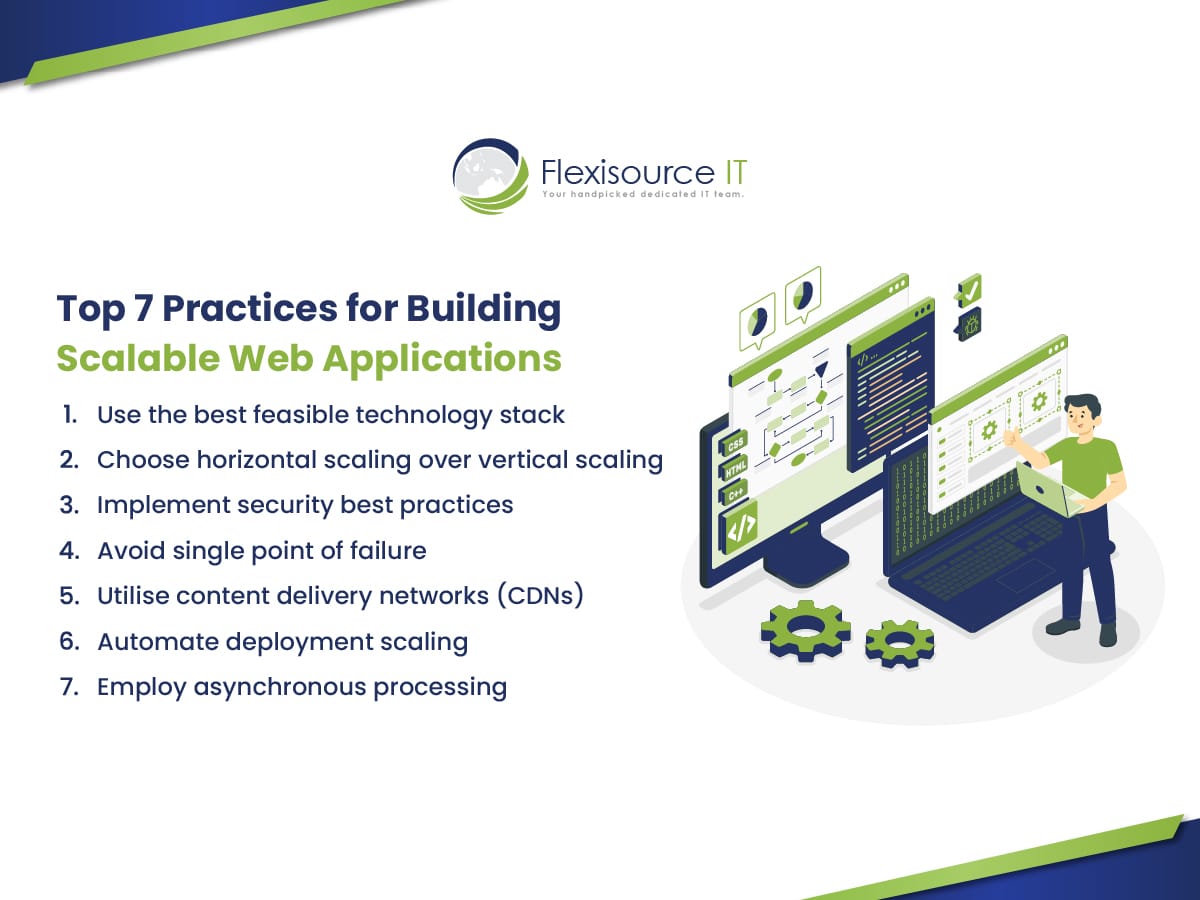Building a web application is one of the biggest investments for a business. Thus, it is necessary that this can be operational and can cater to your customers well. However, as your business grows and you start getting a few more customers, your web application faces a few issues.
So, what is the issue? You are facing a scalability problem. Your web app application is not designed to scale with the increasing load of users, data, and connections.
A big part of developing modern web applications is scalability. No matter what kind of project it is or who you are targeting, it is critical for a web application to be designed with scalability in mind. Thus, in this article, we will guide you on how to create a scalable web application.
What is a scalable web application?
A scalable website application is a web-based application that can handle an increasing amount of traffic and data over time. It is designed to handle increased users, transactions, and data without any performance degradation.
Likewise, this scalability allows businesses to grow their website applications without investing in additional hardware or software infrastructure. By scaling up the website application, companies can ensure that their websites remain available and responsive even during peak usage periods.
Why do you need scalable web applications?
Having a scalable web application is of utmost importance for many businesses. It allows them to quickly respond to changes in customer demand and increase their operations’ efficiency. Scalability also helps companies to save time and money by streamlining processes and providing a better user experience.
Likewise, here are some specific reasons why you need scalable web applications:
- Handling Increased Traffic. A scalable application can accommodate many users and drive increased traffic without experiencing performance issues or downtime. It ensures that the application remains responsive and accessible even during peak usage periods.
- Meeting User Demand. As user demand for a website application grows, scalability allows the application to scale up and handle the increased load. It prevents users from experiencing slow response times or being turned away due to capacity limitations, thus improving user satisfaction.
- Adapting to Changing Demands. User demands, and requirements can change over time. Scalability allows the application to adjust to these changing demands, whether a sudden increase in traffic due to a marketing campaign or a fluctuation in seasonal usage patterns.
- Supporting Business Growth. Scalability is crucial for businesses that anticipate growth or expansion. It enables them to handle a more extensive user base, support increased transactions or interactions, and accommodate new features or services without requiring a complete overhaul of the application infrastructure.
- Enabling Business Continuity. Scalable applications are often designed with fault tolerance and redundancy mechanisms. This guarantees that even in the event of hardware failures or other disruptions, the application can operate without significant downtime, providing uninterrupted service to users.
- Optimising Performance. Scalable applications are designed to efficiently utilise resources and distribute workloads. This optimises the application’s performance by minimising response times, reducing latency, and ensuring smooth user interactions, enhancing user experience.
- Cost Optimisation. Scalability allows businesses to optimise costs by dynamically scaling resources based on demand. They can scale up during peak periods to meet increased traffic and scale down during low-demand periods to avoid unnecessary infrastructure costs.
7 Practices for Building Scalable Web Applications.
Now that you know the profits of scalable web applications, it is time to learn how to ensure your application is one. However, building a scalable web apps requires careful planning and execution. The following techniques can ensure that your web application can handle a growing number of customers:

1. Use the best feasible technology stack
Scalability is not just something you fix when stuck with an issue. It always needs to be integrated from the beginning. Scalability should always be considered when planning and designing your web application.
Thus, choosing and using the right technology is the first step to a scalable web app. Here are some of the most critical elements:
System Architecture
The scalable architecture enables web applications to adapt according to the user’s demand and application performance. Therefore, it can heavily impact scalability. There are several types of web application architecture that you can use, such as monolithic, microservices, serverless, and three tiers. Here is the difference between them:
Monolithic system architecture Is a software architecture that consists of a single, unified application. It is designed to be self-contained and self-sufficient, with all components tightly coupled. This type of architecture provides fast development cycles and better scalability when compared to other architectures. However, it can also become rigid and difficult to maintain as the application grows in complexity.
- Microservice system architecture allows for creation of applications composed of small, independent services. It lets developers break down an extensive application into more manageable pieces that can be developed and deployed separately. This approach has become popular recently due to its scalability and flexibility.
- Serverless system architecture is a revolutionary way of building applications and services without physical servers. It enables developers to build applications faster and with greater scalability while reducing operational costs. In addition, by using cloud-based services such as Amazon Web Services (AWS), companies can quickly deploy their applications and scale them up or down according to demand.
- Three-tier architecture is divided into three separate layers: the data, presentation, and application layers. Each layer has responsibilities, making developing, maintaining, and scaling complex systems more manageable. The three-tier architecture also ensures that changes to one layer do not affect the other. This makes it an excellent choice for large-scale applications that need to be easily maintained over time.
Programming Language and Frameworks
The choice of programming language and frameworks plays a significant role in web application scalability. Different programming languages have varying levels of performance and efficiency. When building scalable web applications, choosing a programming language that can handle high loads and process requests quickly and efficiently is crucial. A language with a low memory footprint and efficient execution can contribute to improved scalability by minimising resource consumption.
2. Choose Horizontal Scaling Over Vertical Scaling
Horizontal scaling adds more machines to a system to increase capacity and performance. In contrast to vertical which includes expanding the resources of an individual device, horizontal scaling.
Likewise, this type of scaling offers several advantages over vertical scaling, such as increased performance, improved scalability, and better cost efficiency. It also allows businesses to quickly add additional resources when needed without investing in new hardware or software.
This approach ensures that scalable web applications can handle increased traffic by dividing the workload across multiple servers.
3. Implement security best practices
Usually, scaling up will magnify any security flaws in a web application. It can also introduce new vulnerabilities and challenges. Scaling typically involves expanding the infrastructure, adding more servers, and increasing the network connections. This expansion enlarges the attack surface, providing more potential entry points for attackers to exploit.
In addition, as a web application scales, an increased volume of sensitive data may be processed, stored, and transmitted. This raises the stakes for data protection. Likewise, it can introduce challenges in managing user authentication and authorisation. As the user base grows, it becomes crucial to implement robust authentication mechanisms and scalable user management systems.
As such, proper security measures must be in place to secure all the components involved in scaling, such as load balancers, additional servers, and communication channels. Adequate security measures, such as encryption, secure storage, and secure communication protocols, must be implemented to safeguard sensitive information from unauthorised access or interception of your scalable web applications.
4. Avoid single point of failure
A single point of failure refers to a component or element within a system that, if it fails, can cause the entire system to fail or significantly impact its operation. It is a vulnerability in the system where a single component’s failure can disrupt the system’s normal functioning. In other words, the loss of this specific component becomes a critical point that can bring down the whole system’s availability, reliability, or performance of a web applications.
Likewise, a single failure point in a web application can pose risks because it lacks redundancy and fault tolerance. A single point of failure is detrimental to the scalability of a web application because it undermines its ability to handle increased loads and growing demands. This can result in downtime, loss of productivity, financial loss, or even compromise the system’s security.
To achieve scalability, it is essential to identify and address any single points of failure in the architecture of a web application. By implementing redundant systems, load balancing, distributed components, and fault-tolerant measures, the application becomes more resilient and capable of handling increased loads while maintaining availability and performance. Removing single points of failure is crucial for ensuring scalable web applications’ scalability, reliability, and robustness.
5. Utilise content delivery networks (CDNs)
A Content Delivery Network (CDN) is a geographically distributed network of servers designed to deliver web content efficiently to end users. It caches and serves static and dynamic content, such as HTML pages, images, videos, JavaScript files, and other media, from multiple edge locations or points of presence (PoPs) across various geographic regions.
When a user requests data from a website, the CDN selects the nearest edge server based on the user’s location. The edge server caches and serves the content to the user, reducing the distance and network latency between the user and the content. This proximity improves the delivery speed and overall performance of the web application.
Likewise, a Content Delivery Network (CDN) can significantly contribute to the scalability of a web application in several ways:
- Reduced Server Load. By caching and serving static content from these edge servers, CDNs offload the workload from the origin server. This reduces the server load and allows the origin server to focus on handling dynamic content and processing application logic.
- Improved Performance. CDNs bring the content closer to end users by caching it in edge servers distributed across various geographic locations. When a user requests data, the CDN delivers it from the nearest edge server, reducing network latency and improving delivery speed.
- Scalable Bandwidth. Since the content is distributed across multiple edge servers, the CDN can handle simultaneous requests from numerous users without causing network congestion or performance degradation.
- Caching and Content Offloading. By caching static and dynamic content at edge servers, CDNs reduce the load on the origin server and minimise the need for repeated content retrieval.
6. Automate deployment scaling
Automation deployment scaling refers to automatically adjusting the resources and capacity of a web application based on demand without requiring manual intervention. It involves setting up systems and processes to dynamically scale the application’s infrastructure to handle increased traffic or workload.
When an application experiences high traffic or demand, automation deployment scaling allows the application to automatically allocate additional resources, such as compute instances, containers, or virtual machines, to handle the increased load. Conversely, when the demand decreases, the scaling mechanism can automatically reduce the allocated resources to optimise cost and resource utilisation.
7. Design for fault tolerance
Fault tolerance refers to the capacity of a system to continue functioning and providing its intended services in the presence of faults or failures. It is a system property that enables it to gracefully handle any unexpected errors or disruptions without experiencing a complete breakdown.
Designing a web application for fault tolerance involves implementing strategies and practices to ensure continuous operation and resilience in the face of faults or failures. Here are some considerations for designing a fault-tolerant application:
- Introduce redundancy in critical components of the application to minimise the impact of failures. This includes replicating servers, databases, and other resources across multiple availability zones or data centres. Redundancy ensures that if one component fails, another can take over seamlessly, maintaining service availability.
- Employ load-balancing mechanisms to distribute incoming traffic across multiple instances or servers. Load balancers can detect and route traffic away from failed or underperforming components, ensuring the application remains accessible and responsive. This facilitates scaling and can handle increased traffic during peak periods.
- Implement a robust monitoring system to detect and respond to faults promptly. Monitor key metrics, such as resource utilisation, response times, and error rates. Set up alerts to notify administrators or operations teams when thresholds are breached, or anomalies occur.
- Ensure data durability and integrity by implementing data replication and backup strategies. Use techniques such as database replication, transaction logs, or distributed file systems to replicate and store data across multiple locations. Regularly back up critical data to remote or redundant storage systems to safeguard against data loss.
- Conduct rigorous testing to simulate and evaluate system behaviour under various failure scenarios. Perform load testing, stress testing, and simulate component failures to validate the application’s fault tolerance capabilities. Use tools and frameworks that enable fault injection to proactively identify weaknesses and improve resilience.
Conclusion
Scalable web applications can help your business’ growing needs. Thus, whether you are a small business or a large enterprise, scalability must be kept in mind when building a web application.
And while developing scalable web applications is challenging, these best practices will surely help everyone on your development team. Moreover, suppose you need help building high-performance, scalable web apps. In that case, Flexisource IT is here to help you! Let us help you create the web application of your dreams!





